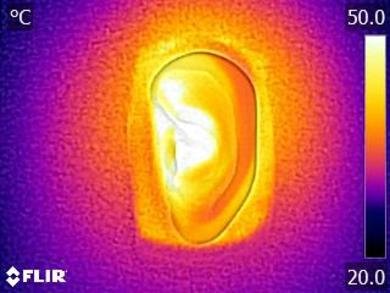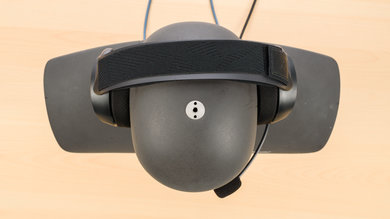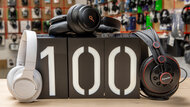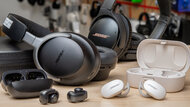The SteelSeries Arctis Pro Wireless are good gaming headphones. They combine the connectivity options of the SteelSeries Arctis 7 Wireless 2017 and the SteelSeries Arctis Pro GameDAC by including a wireless transmitter that doubles as a battery charging station, and they even throw in Bluetooth support for good measure. This results in highly versatile wireless gaming headphones that can mix audio from a console and a mobile device at the same time. On the downside, there have been many user reports of their units' hinges breaking over a short amount of time, and you can read more in our build quality section.
Our Verdict
The SteelSeries Arctis Pro Wireless are decent for neutral sound. While their bass and treble delivery depend on their fit, seal, and positioning, the USB transmitter and their companion software offer a graphic EQ and presets that make it easy to tweak the way they sound to your tastes.
- Comfortable design.
- Bass and treble delivery varies significantly across users.
The SteelSeries Arctis Pro Wireless are passable for commuting. You can pair them to your mobile devices via Bluetooth or use them passively with the provided audio cable. Although they don't mitigate background noise very well, the microphone is retractable, and they're quite comfortable, so they're an alright option for commuting if you don't mind the over-ear design.
- Comfortable design.
- Poor noise isolation.
The SteelSeries Arctis Pro Wireless are okay for sports. They're bulky but have breathable padding on their ear cups. You can also use them wirelessly with mobile devices, and they're decently stable thanks to their tight yet comfortable fit. However, they won't be the most practical for physical activities since you can get quite warm exercising with them on, and they're prone to slipping off. They also have a mediocre build quality, and their hinges may break over time.
- Comfortable design.
- Poor noise isolation.
The SteelSeries Arctis Pro Wireless are decent for office use. The SteelSeries Engine provides you with a good amount of customization options, and they're comfortable enough to wear for long hours. Their microphone is great for taking calls and you can use them wirelessly by plugging the wireless transmitter into your work computer as well as by pairing them to your mobile Bluetooth device. They won't block much office chatter, but they also don't leak as much as other gaming headsets. Their battery life can also last a whole workday.
- Impressive battery system.
- Wireless via USB transmitter and Bluetooth.
- Poor noise isolation.
- Bass and treble delivery varies significantly across users.
The SteelSeries Arctis Pro Wireless are good for wireless gaming. They can be used with a console and mobile device at the same time, have an excellent mic that filters a lot of noise, and are comfortable. They also have low wireless latency via their wireless transmitter base. Like most gaming headphones, they have poor noise isolation, but it won't be a problem if you game in a quiet room. That said, they have a unique and convenient battery charging system and are likely to keep up with even the most prolonged gaming sessions.
Great microphone performance.
- Impressive battery system.
- No button to adjust microphone volume.
The SteelSeries Arctis Pro Wireless are decent for wired gaming. They're comfortable for long gaming sessions, and their boom microphone captures voices clearly, even in more demanding environments. Their wireless transmitter is also nice for tweaking your audio on the fly. Unfortunately, they lack an adjustable mic level control. They also have poor noise isolation, but they'll be more than adequate if you're gaming at home.
Great microphone performance.
- No button to adjust microphone volume.
The SteelSeries Arctis Pro Wireless are good for phone calls. Their boom microphone captures voices clearly, even in noisy environments. However, they don't have the best noise isolation so background sound can seep into your audio, making it more difficult to hear the person on the other end of the line.
Great microphone performance.
- Impressive battery system.
- Wireless via USB transmitter and Bluetooth.
- Poor noise isolation.
- No button to adjust microphone volume.
Changelog
- Updated Jan 06, 2025:
Several Sound tests have been updated following Test Bench 1.8. Text changes have also been made throughout the review, including the Usages and Product Comparisons, to match these results. We want to ensure you see our more recent data, so some outdated text has been removed.
- Updated Dec 16, 2024: We've converted this review to Test Bench 1.8, which updates our target curve and Sound tests. You can read more about this in our changelog.
- Updated Jul 12, 2024: We've converted this review to Test Bench 1.7, which updates our Noise Isolation test. We've also expanded the scope of this test to include Common Scenarios in addition to Voice Handling and Wind Handling.
- Updated Mar 15, 2024: We've added a comparison between these headphones and the Astro A50 X in Base/Dock.
Check Price
Differences Between Sizes And Variants
The SteelSeries Arctis Pro Wireless come in a 'Black' and 'White' variant.
If you come across another variant, let us know in the comments, so we can add it to our review.
Popular Headphones Comparisons
The SteelSeries Arctis Pro Wireless combine the wireless support of the SteelSeries Arctis 7 Wireless 2017 with the customizability of the SteelSeries Arctis Pro GameDAC, making them jam-packed with features. What really sets them apart from other gaming headphones, however, is their swappable dual-battery charging system. They also have Bluetooth support so you can channel mix your gaming audio with team chat from your mobile device.
If you're still looking for gaming headphones, check out our recommendations for the best PS4 gaming headsets or the best PS5 gaming headsets.
The SteelSeries Arctis Nova Pro Wireless have an edge over the SteelSeries Arctis Pro Wireless. The Arctis Nova Pro deliver audio more consistently and have ANC to help block out an alright amount of background noise. Their total battery life is longer, and you can even get these headphones in an Xbox or PlayStation variant, which offers different compatibility with either console. However, the original Arctis Pro's mic offers better overall performance in both noise handling and recording quality.
The SteelSeries Arctis Pro Wireless are more versatile gaming headphones than the HyperX Cloud Alpha Wireless. You can use the SteelSeries wired or wirelessly, and their microphone offers better overall performance. They also support Bluetooth, which is good if you want to receive audio from your smartphone while connected to your PC. Their wireless transmitter base has a few different inputs too. However, the HyperX are more comfortable, and their continuous battery life is significantly longer. Some users have reported that using the companion app's features adds high latency though.
The SteelSeries Arctis Pro Wireless and the Sony WH-1000XM4 Wireless are designed for different uses. The SteelSeries are wireless gaming headphones. They have a better overall performing boom mic, support Bluetooth, and support non-Bluetooth wireless. They also come with a transmitter which allows you to adjust more controls like channel mixing and audio sources on the fly. In contrast, the Sony are better suited for casual use. They're more comfortable, can be paired with up to two devices at a time, and have an ANC system that helps block out a lot of background noise.
The SteelSeries Arctis Pro Wireless are more versatile gaming headphones than the Astro A50 Gen 4, as you can use them wired or wirelessly. Although the SteelSeries are prone to more inconsistencies in their audio delivery, their sound can be tweaked on the fly, thanks to the EQ on their wireless transmitter. You can use their dock to store an extra physical battery while another is in your headphones, so you shouldn't have to worry about running out of power. They support Bluetooth, which is nice if you like to stream audio from your phone while gaming. However, the Astro have the edge when it comes to wireless gaming. They have even lower wireless latency via their base station, a more comfortable fit, and their boom mic offers a slightly better overall performance.
Test Results

The SteelSeries Arctis Pro Wireless are very similar in design to the rest of the Arctis lineup. They have a wide metal headband with a pronounced curve wrapped in an elastic strap to adjust the fit, reminiscent of ski goggles, that has a premium, durable feel. They’re a bit bulky, but have a retractable microphone for added versatility. They have a sleek, uniform look that's more understated than gaming headsets with flashier designs like the Astro A50 Gen 4 Wireless 2019, but is more versatile for everyday use. If you want your headphones to stand out more though, you can purchase more colorful headband straps, magnetic ear cup plates, and leather or velour ear cushions directly on the SteelSeries website.
Like the SteelSeries Arctis 7 2019 Edition Wireless and the SteelSeries Arctis Pro GameDAC, the SteelSeries Arctis Pro Wireless are comfortable gaming headphones. They have a curved metal headband frame with a ski goggle-like elastic that adjusts the fit. The ear cups are large, spacious, and well-padded, and are coated with breathable and soft padding that feels nice on the skin. Unfortunately, the sizing is limited by the length of the elastic strap and the shape of the metal frame, which can’t expand to accommodate all head shapes and sizes. The fit will be fine for most but may feel a little tight for some.
The SteelSeries Arctis Pro Wireless have good controls that are easy to use and provide great feedback. Like the SteelSeries Arctis Pro GameDAC, these headphones have a control dial and a microphone mute switch on the left ear cup. When using Bluetooth, the control dial only adjusts the volume. If you're using the transmitter, you can also adjust the volume by default, but clicking the dial accesses more settings like channel mixing, EQ presets, and audio sources. The right ear cup has a power button and a dedicated Bluetooth Sync button, which controls music and calls when you're using a Bluetooth connection. The power button also curves outwards while the Bluetooth button curves inwards, which helps to distinguish the two.
Like most closed-back, over-ear headphones, the SteelSeries Arctis Wireless Pro Wireless have poor breathability. These headphones aren't suitable for sports or exercise since they can make your ears sweat if used while working out. They can also warm your ears up a bit during longer or more intense gaming sessions. That said, you won't have a problem during more casual gaming or listening sessions, especially if you take breaks every now and then.
Like most gaming headphones, the SteelSeries Arctis Pro Wireless aren't very portable. Even though they have practically the same design as the SteelSeries Arctis 7 Wireless 2017 and the SteelSeries Arctis Pro GameDAC, they’re a bit larger too. They have large ear cups, a rigid headband, and they can't fold into a more compact format. Their wireless transmitter is also fairly bulky. However, you don't need to carry it with you when you're on the go as these headphones have Bluetooth support or can be used passively with their audio cable. Still, they're not the easiest to carry around unless you have a bag or backpack to stash them in.
The SteelSeries Arctis Pro Wireless don't come with a case or a pouch. However, you can purchase one directly from SteelSeries.
Despite their high-end price, the SteelSeries Arctis Pro Wireless have a mediocre build quality. They’re nearly identical to the SteelSeries Arctis Pro GameDAC with a mostly plastic frame and a headband that's a mix of metal and silicone-like material. Unfortunately, there have been multiple user reports of the hinges of the headphones breaking over short and long periods. The plastic yoke area can crack and cause the hinge completely break off, which is very frustrating.
Unlike most other gaming headphones, the right ear cup houses a removable battery, and the headphones come with two swappable batteries. The microphone is flexible and can withstand being bent in different ways without breaking. It also smoothly retracts into the left ear cup when not in use.
The SteelSeries Arctis Pro Wireless have similar stability to the SteelSeries Arctis 7 Wireless 2017 and the SteelSeries Arctis 7 2019 Edition Wireless. They have a tight yet comfortable fit that prevents them from moving much once on your head. Since they’re also wireless, there’s no audio cable that can snag on something and yank them off your ears. That said, their fit is tight enough that you can jog with them if you want to, provided you don’t mind your ears getting a little warm.
The SteelSeries Arctis Pro Wireless have sub-par frequency response consistency. The bass delivery varies, and a drop in bass can occur if the ear cups aren't flush to your head, like if you wear glasses or have thick hair. The treble range is also inconsistent. As the overall frequency response depends on fit, seal, and positioning of these headphones, once you achieve a good overall fit, you'll get a more consistent frequency response each time you use them.
The SteelSeries Arctis Pro Wireless have excellent imaging. Although there are two small spikes in the low-bass and mid-bass that are above the group delay's audibility threshold, it may not be audible for most users. Additionally, the L/R drivers of our test unit are exceptionally matched, which is important for the accurate placement and localization of objects and instruments (like voices and footsteps) in the stereo image. However, these results are only valid for our unit and yours may perform differently.
The SteelSeries Arctis Pro Wireless have an unremarkable soundstage. Although it feels relatively large and sounds as if it's coming from out of the listener’s head, the soundstage may still be perceived as a bit unnatural. As they have a closed-back design, it results in a soundstage that may not feel as open as that of open-back headphones.
These headphones have virtual sound support and a speaker modeling feature.
The SteelSeries Arctis Pro Wireless' weighted harmonic distortion performance is good. Although there's a small spike in the low-bass, this likely won't be audible to all listeners. Otherwise, all frequencies fall within good limits, which will result in clear and pure audio reproduction.
Update 07/23/2021: We originally reported that we tested these headphones using PCM, 24-bit, 48kHz codec. However, this was incorrect and thanks to user feedback, we've updated our results with the correct codec settings: PCM, 16-bit, 48kHz.
The SteelSeries Arctis Pro's results are only valid for these settings.
The SteelSeries Arctis Pro Wireless have poor noise isolation. They don’t isolate sounds in the bass range at all and instead, they can let the rumbles of a subwoofer into your audio. Although they block out slightly more mid-range noise like office chatter, it won't be enough for an office or cafe setting. On the upside, they do a better job of reducing treble range noise like A/C fans. However, if you want gaming headphones with better noise isolation, check out the EPOS Sennheiser GSP 600. The SteelSeries Arctis Nova Pro Wireless are also worth considering as they have an active noise cancelling (ANC) system.
The leakage performance of the SteelSeries Arctis Pro Wireless is decent, similar to that of the SteelSeries Arctis 7 2019 Edition Wireless. They mostly leak between the low-mid to low-treble and it sounds fuller and speaker-like than leakage coming from in-ear or more tightly closed-back, over-ear headphones. If you're listening to music at a high volume, it may be audible to those around you, even in a moderately noisy environment.
Update 04/03/2019:A few reports mention a hissing noise that could be a deal-breaker for some users. This issue seems to be related to the mic as setting the sidetone level to 0 and turning volume limiter off slightly helps. However, this seems inconsistent and may vary per unit, as some users don't have this issue. We have a very slight hiss with our unit, but it's barely audible, especially when you have audio playing.
These headphones have a retractable boom microphone that also comes with an optional windscreen.
The SteelSeries Arctis Pro Wireless' microphone has a very good recording quality. Speech recorded sounds full-bodied, clear, and detailed. However, it lacks airiness and brilliance. As the microphone doesn't have volume control, it's always at max volume, which causes the recording to sound distorted in our test PC.
There have been numerous reports on user forums of the SteelSeries Arctis Pro Wireless' microphone being too quiet on consoles and mobile apps. Resetting the wireless transmitter and updating the firmware seems to resolve this issue for many. You can visit this link to see the discussion surrounding this issue.
The microphone of the SteelSeries Arctis Pro Wireless has remarkable noise handling. It can easily separate your voice from demanding or noisy environments like gaming events, so you can be heard clearly.
Update 10/12/2021: We retested both batteries to see if we could achieve a result closer to the advertised 10 hours of continuous battery life. We were able to measure roughly 13 hours of playback time. However, our unit is over a year old and has seen a lot of use, which could explain the difference between our original measurement of roughly 15 hours and this measurement of 13 hours. We also managed to get more than the advertised 10 hours of battery life after both retests, and even though these headphones have been regularly used for several months. As a result, we haven't changed our results.
These headphones have an excellent battery system. Two swappable batteries can be inserted into the wireless transmitter for charging when not in use. They use one battery at a time, and they each have over 15 hours of continuous battery life, which means that you don't have to worry about running out of juice during more intense gaming sessions. When you're deep in gameplay, the transmitter can also show the charge level of your headphones as well as the battery that's being charged. There's even an auto-off timer that can be set via their companion software, and if you can't put down the game, you can also use these headphones while charging. You can also use them passively with their included audio cable.
The SteelSeries Arctis Pro Wireless are compatible with the SteelSeries Engine desktop app, which is a good app with lots of customization features for gamers. You won’t get as many features as you do with the SteelSeries Arctis Pro GameDAC, but there’s a graphic equalizer with presets, DTS surround sound, live mic preview, bass boost, and dialogue enhancement, to name a few. The charge level of the battery in the headset and the battery in the transmitter is available on the app, and the app specifies when the charging battery is fully charged.
The SteelSeries Arctis Pro Wireless come with an uncommon mini B 8-pin connector cable that connects directly to the headphones. However, the other end is a 1/8" TRRS cable that's compatible with most gaming consoles and operating systems. When the headphones are on, they have slight latency via analog, but your audio and visuals are still well-synced. Using them completely passively drops the latency to virtually imperceptible levels, though.
The SteelSeries Arctis Pro Wireless have okay Bluetooth connectivity. Although they don't support multi-device with more than one Bluetooth device like the Turtle Beach Elite 800 Wireless, you can still pair them with a Bluetooth device. You can also connect to a PlayStation console and a Bluetooth device simultaneously. With this setup, you can listen to audio from your smartphone while still gaming.
These headphones only support the basic SBC codec. The latency using this codec is quite high, causing lip-sync issues. Some apps and devices compensate for latency, though. Bluetooth also isn't really the best choice for gaming, so if you're looking for lower wireless latency, you'll want to see how the wireless transmitter base performs.
These headphones have excellent wireless connectivity via their wireless transmitter base. Their audio latency is quite low, ensuring your audio and video stay in sync. They also have a very good line-of-sight range, allowing you to use them further away from their audio source.
The SteelSeries Arctis Pro Wireless can only receive audio when their wireless transmitter is connected to the Xbox One via an optical connection. If you like to stay in touch with your teammates using your microphone, you can use a Bluetooth connection with a phone or other device that has the Xbox app for chat. However, you have full audio and microphone support when you plug their analog cable directly into the controller.
Update 03/27/2019: The SteelSeries don't have native mic support with the Xbox One. You have to use the Bluetooth connection with a phone or device that has the Xbox app for chat. You can also use a USB connection with your PC. For full instructions on how to set this up, you can read more by following this link. However, since the microphone isn't being routed through the Xbox console, we have adjusted the score to reflect this.
The SteelSeries Arctis Pro Wireless come with a USB wireless transmitter base. The headset's battery is charged directly in the transmitter and is inserted like a cartridge. You plug the transmitter into a USB port of a PC or console to use the headset wirelessly. Optical audio is required to use these headphones with the Xbox One or to access the surround sound and ChatMix features on PS4. If you're looking for headphones with a base station that supports HDMI passthrough and offers simultaneous connectivity with PC, Xbox and PlayStation family consoles, it's worth checking out the Astro A50 X Wireless instead.




























































































